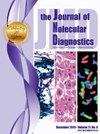Performance Evaluation of a Next-Generation Sequencing–Based T-Cell Receptor Gene Rearrangement Assay
IF 3.4
3区 医学
Q1 PATHOLOGY
引用次数: 0
Abstract
T-cell receptor (TCR) gene rearrangement clonality studies help resolve atypical T-cell proliferations in the context of suspected malignancy. However, the interpretation criteria for this assay using a next-generation sequencing (NGS) platform have not been extensively explored and standardized. Thus, this project assessed the current performance of the Stanford Health Care in-house NGS-based TCR clonality diagnostic testing with the goal of optimizing the interpretation criteria and identifying recurrent analytical challenges. The current assay identifies a predominant clonotype when its sequence comprises at least 2.5% of the total reads with at least 5× fold change from the background. Using concurrent pathology reports as the clinical truth, this project analyzed 619 cases and determined that the current assay performs at 74% sensitivity and 85% specificity. Receiver operating characteristic analysis identified an optimized interpretation criterion that only improved the diagnostic yield marginally compared with the preexisting algorithm. Further clinicopathologic evaluation of discordant cases revealed that discrepancies mostly arose from technical limitations or the underlying nuanced biology of the diagnosis. Overall, this study provides an objective approach in establishing the interpretation criteria of the current NGS-based TCR clonality test and offers a roadmap for other laboratories considering implementing a similar assay.
基于测序的下一代t细胞受体基因重排测定的性能评价。
t细胞受体(TCR)基因重排“克隆性”研究有助于解决可疑恶性肿瘤背景下的非典型t细胞增殖。然而,使用下一代测序(NGS)平台的该分析的解释标准尚未被广泛探索和标准化。因此,本项目评估了斯坦福医疗中心内部基于ngs的TCR克隆诊断测试的当前性能,目标是优化解释标准并确定反复出现的分析挑战。当其序列至少占总读取量的2.5%且与背景相比至少有5倍的变化时,当前的检测识别出优势克隆型。使用并发病理报告作为临床事实,该项目分析了619例病例,并确定当前的检测方法具有74%的敏感性和85%的特异性。受试者工作特征(ROC)分析确定了一个优化的解释标准,与已有的算法相比,该标准仅略微提高了诊断率。对不一致病例的进一步临床病理评估显示,差异主要是由于技术限制或诊断的潜在细微生物学。总的来说,本研究为建立当前基于ngs的TCR克隆检测的解释标准提供了客观的方法,并为其他考虑实施类似检测的实验室提供了路线图。
本文章由计算机程序翻译,如有差异,请以英文原文为准。
求助全文
约1分钟内获得全文
求助全文
来源期刊
CiteScore
8.10
自引率
2.40%
发文量
143
审稿时长
43 days
期刊介绍:
The Journal of Molecular Diagnostics, the official publication of the Association for Molecular Pathology (AMP), co-owned by the American Society for Investigative Pathology (ASIP), seeks to publish high quality original papers on scientific advances in the translation and validation of molecular discoveries in medicine into the clinical diagnostic setting, and the description and application of technological advances in the field of molecular diagnostic medicine. The editors welcome for review articles that contain: novel discoveries or clinicopathologic correlations including studies in oncology, infectious diseases, inherited diseases, predisposition to disease, clinical informatics, or the description of polymorphisms linked to disease states or normal variations; the application of diagnostic methodologies in clinical trials; or the development of new or improved molecular methods which may be applied to diagnosis or monitoring of disease or disease predisposition.

 求助内容:
求助内容: 应助结果提醒方式:
应助结果提醒方式:


